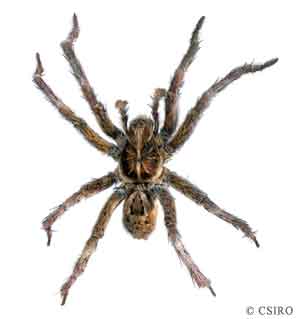|
Araneae:
spiders
Characteristics
Spiders
are one of the most easily recognisable orders among the invertebrates
and differ from other arachnids in having abdominal glands that
produce silk. Spiders come in a variety of shapes, colours and sizes.
They can range in size from minute, spiders less than 0.5 millimetres
up to a huge size with a 20 centimetre leg-span. Spiders have the
following features in common:
- 4
pairs of legs.
- Usually
4 pairs of eyes although some species may have less
- 2
discernible body sections; the cephalothorax
which contains the head fused with the thorax; and the abdomen
which houses the internal organs
- Spinnerets
at the end of the abdomen, which are used for spinning silk threads
used for a variety of purposes such as the construction of webs,
snares and retreats in which to live or to wrap prey
- Fangs
(or chelicerae)
used to deliver venom to kill prey, for defence, to capture and
crush prey and to dig and excavate burrows
- 1
pair of sensory palps
(often much larger in males) between the first pair of legs and
the chelicerae,
used for sperm transfer during the mating season, prey manipulation
during feeding and detection of smells and vibrations
- 1
to 2 pairs of book-lungs on underside of abdomen
There
are 2 main groups of Australian spiders:
Primitive
spiders (Mygalomorphs):
this group of spiders have 2 pairs
of book-lungs
on the underside of the abdomen and have chelicerae
which work in an up and down fashion. They usually have 2 pairs
of spinnerets,
which feed out silk from the end of the abdomen.
True or Modern
spiders (Araneomorphs):
this group of spiders have
1 pair of book-lungs
on the underside of the abdomen and their chelicerae
work from side-to-side. Most have 3 pairs of spinnerets
and a spinning plate called a cribellum
(although some species have lost this feature).
Life Cycle
Only
after their final moult
do male spiders become sexually mature. At this point they stop
feeding and spend all their time and energy trying to find a female
to mate with. When a mate is found the male spiders will transfer
his sperm to the female via his syringe-like pedipalps.
After
mating the male will either die or be eaten by the female. A short
time later the female will lay her eggs into a silken sac, which
varies in shape and size depending on the species. Anywhere from
a few up to hundreds of eggs may be laid in a single egg sac that
she will usually guard from predators. On hatching the spiderlings
resemble very small adults and are generally lighter in colour.
The young may spend their first growth period within the egg sac
after which they disperse, construct their own webs to catch food
so they can feed and grow. Growth occurs by shedding their skin
(moulting) in the same way as other arthropods and several moults
are required before spiders reach adulthood. From egg to adult usually
takes from 6 to 12 months, however some ground dwelling species
may take up to 4 years to reach sexual maturity.
Feeding
Most
species of spider are active at night and all are predatory, feeding
on a wide range of other invertebrates. Cannibalism may also occur
among spiders especially where there is overcrowding. Different
species of spiders use a variety of methods to capture their prey,
but most usually construct sticky silk webs or threads to trap potential
prey. Other species chase their prey often capturing them with rapid
lunges. The venom that spiders produce is predominantly used to
kill or immobilise their prey by being injected through hollow fangs
into the captured animal. The prey is then squeezed or held by the
strong basal section of the fangs and saliva in the spiders upper
lip digests the body contents. The insides of the victim are then
consumed and the hard outer body discarded.
Habitat
Spiders
are found in all terrestrial habitats across Australia and some
have even adapted to a semi-aquatic lifestyle. They are common inhabitants
of almost every kind of habitat and may be found in all types of
forest environments from moist tropical rainforests to dry Eucalyptus
forest and woodland, they are common in scrubland, desert regions,
caves and around human habitation. Spiders can commonly be found
in leaf litter and under rocks, logs or the bark of trees. Many
dig burrows in the soil while others spin distinctive webs amongst
vegetation.
For more information
on some of the more common spiders see the CSIRO Entomology Identification
and Advice Service page on spiders.
|


